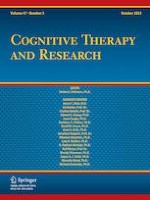21-05-2023 | Original Article
Beyond Logical Errors: Preliminary Evidence for the “Looming Vulnerability Distortions Questionnaire” of Cognitive-Perceptual Distortions in Anxiety
Gepubliceerd in: Cognitive Therapy and Research | Uitgave 5/2023
Log in om toegang te krijgenAbstract
Background
In cognitive models, faulty threat appraisals that are associated with threat cognitions in anxiety are frequently seen as the outcome of logical errors. The looming vulnerability model expands upon such views by emphasizing the role of perceptual and phenomenological distortions in threat estimation. It assumes that anxiety is associated with cognitive-perceptual distortions of time, space, and movement (e.g., space and time compression) that heighten the subjective impression that threats are rapidly approaching, even when they aren’t. The present study was undertaken to develop an easy-to-administer and implement self-report measure to assess such perceptual distortions.
Methods
University students (N = 751; 71% female) completed a battery of online questionnaires that included the Looming Vulnerability Distortions Questionnaire (LVDQ) and measures of the looming cognitive style (LCS), cognitive distortions, social desirability, anxiety, worry, intolerance of uncertainty, and depression.
Results
A bifactor ESEM model displayed excellent fit indices and reliability for the LVDQ. Although the results provided strongest support for the use of a general score over specific subscales, they also support the secondary use of some specific scores for some types of distortions. The LVDQ uniquely predicted variance in LCS, anxiety, worry, intolerance of uncertainty, and depression. Moreover, both the LVDQ and LCS also uniquely predicted scores on a face-valid lab-based task, not explained by logical reasoning distortions.
Conclusions
These results support the idea that the LVDQ is a valid measure of cognitive-perceptual distortions associated with anxiety and indicate that it predicts unique variance in anxiety and other emotional distress not explained by a typical measure of logical errors. Clinical implications and future directions are discussed.
